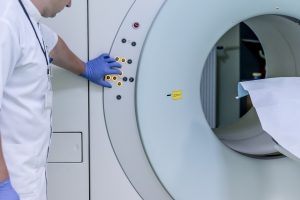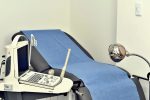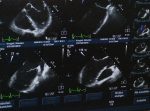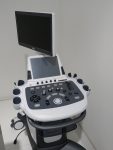
Page Navigation
What is Diagnostic Imaging?
- Diagnostic Imaging – Technology that produces images of body parts to diagnose illnesses.
- Radiology – This is a procedure when technology is used to produce images of body parts to diagnose illnesses. The term is used interchangeably with “diagnostic imaging.”
- Anatomy – The medical terms for the individual parts of the body.
- Pathology – Abnormal functions of the body.
Radiology Terminology
Radiology is a field of medicine that includes several different types of imaging.
The common types of radiology are x-ray, CT, MRI, nuclear medicine, and ultrasound.
- Radiologist – Those are medical doctors that specialize in reading and interpreting diseases and injuries with the use of different modalities of medical imaging.
- Radiology Technician – This is a person who performs medical imaging in more than one specialty.
Sonography Terminology
Sonography or ultrasound is a special procedure performed by a sonographer or ultrasound technologist or technician.
Actually, sound waves are used to produce images of different parts of the anatomy.
- Sonographer – A professional who performs an ultrasound, and it is commonly referred to as an ultrasound technologist and an ultrasound technician.
- Sonography – This is a procedure of taking and interpreting images of body structures taken by producing soundwaves that are returned to the transducer.
- Ultrasound Technologist – A person who performs an ultrasound, that is, a sonographer or an ultrasound technician.
- Ultrasound Technician – Also, a professional who performs an ultrasound. The term is used interchangeably with sonographer and ultrasound technologist.
- Probe – This is a handheld “camera” used by sonographers whose aim is to transmit the sound waves into the appropriate area of the body. It is also referred to as a transducer.
X-Ray Terminology
X-rays are done by technologists or technicians who work on an x-ray machine.
These tools have the aim to obtain images of anatomy, most commonly bone.
It is a frequently used technique as it is a quick and painless procedure.
Bone and metal are both shown as white, making them easy to evaluate.
- X-Ray Technologist – This is someone who performs x-rays for interpretation by a radiologist. The term is used interchangeably with an x-ray technician.
- Radiography Technician – It is a person who performs x-rays and this term is used interchangeably with an x-ray technologist or x-ray technician.
- Radiograph – An x-ray film with an anatomical image.
MRI Terminology
Magnetic resonance imaging, or MRI, is often used to evaluate the soft tissue structures, such as the brain, or identify tumors within the body.
MRI technologists are well-educated professionals in the radiology field who operate a tool that uses magnets and radio waves rather than radiation.
- MRI – It stands for Magnetic Resonance Imaging, that is, images of the body that are produced using magnetic and radio waves.
- MRI Technologist – This is a professional who performs MRI exams that are later on used by a radiologist. the term is used interchangeably with an MRI technician.
CT Terminology
Computed tomography – This is a special field in radiology, and these professionals are capable of images of all types of tissue, including soft tissue, bone, and vasculature.
The computerized manipulation of the special x-rays in CT allows for a three-dimensional evaluation of anatomy.
- CT – It stands for computed tomography, that is, a computerized form of x-ray used for a more detailed evaluation of anatomy or pathology.
- CT Technologist – This is a person who performs CT exams. The term is used interchangeably with a CT technician.
Nuclear Medicine Terminology
Nuclear medicine technologists are extremely skilled and educated professionals who utilize special medicine to allow a person’s anatomy to be radioactive for a short time to better take images of it.
This is a type of radiology which is not only focused on imaging the anatomy but on evaluating its function.
Nuclear medicine can also be used to treat some conditions.
- Nuclear medicine – This is a branch of medical imaging that utilizes radioactive material in order to diagnose and treat disease.
- Radiopharmaceuticals – Radioactive medication is given to the patient so that their anatomy t radioactive for a short time.
- Gamma camera – This is a special camera used to receive the radiation emitted from the patient’s body during a nuclear medicine exam.
- PET Scan – It stands for Positron Emission Topography and this is one of the most common types of nuclear medicine scans.
Sub-Specialties
If you think about getting more advanced and special knowledge, you can choose to get a sub-specialty credential.
This is a more focused area and ultrasound has the most sub-specialties.
By getting this credential, you will focus on the images specific to that specialty and you may not do any imaging of the areas included in the other sub-specialties.
Vascular – This is specific imaging related to the blood flow throughout the body, focusing on the applicable individual veins and arteries needed for the type of exam being performed.
Cardiac – Imaging related to the heart, related to all aspects of the heart and the blood flow through and around the heart.
You can choose to focus on one of the three specialties within cardiac or decide to work within more than one, as the training often overlaps.
- Adult
- Pediatric
- Fetal
General Abdomen – This kind of subspecialty is related to the internal organs not included in other specialties, such as liver, kidneys, pancreas, gallbladder, thyroid, scrotum, and female pelvic. This specialty is often combined with vascular.
OBGYN – General or low-risk pregnancy.
MFM – Maternal-Fetal Medicine – Specialty related to a high-risk pregnancy.
Radiology Certification Terminology
- Board – This is an exam that a person must pass in order to become credentialed in a specialty. Used interchangeably with the registry.
- ARDMS – American Registry of Diagnostic Medical Sonography – this is a credentialing body of registered sonographers.
- SPI – Sonography Principals and Instrumentation – This is a board exam that focuses on the physics of ultrasound and instrumentation. It is required to be passed prior to applying for any other registry with the ARDMS.
- RVT – Registered Vascular Technologist – This is a credential obtained after passing the board for vascular ultrasound.
- DCS – Diagnostic Cardiac Sonographer – This is a credential obtained after passing the ultrasound registry for adult or fetal cardiology.
- RDMS – Registered Diagnostic Medical Sonographer – This is a credential obtained after passing an ultrasound registry board in the following subspecialties:
- OBGYN
- Abdomen
- Breast
- Fetal Echo
- ARRT – American Registry of Radiologic Technologists – This is a credentialing body of registered radiologic technologists in multiple subspecialties.
- RT – Registered technologist – This is a credential held by x-ray technologists.
- MR – This is a credential obtained after becoming certified in MRI.
- CT – The credential obtained after becoming certified in CT.
- NMTCB – Nuclear Medicine Technology Certification Board – This is the premium credentialing board for nuclear medicine.








